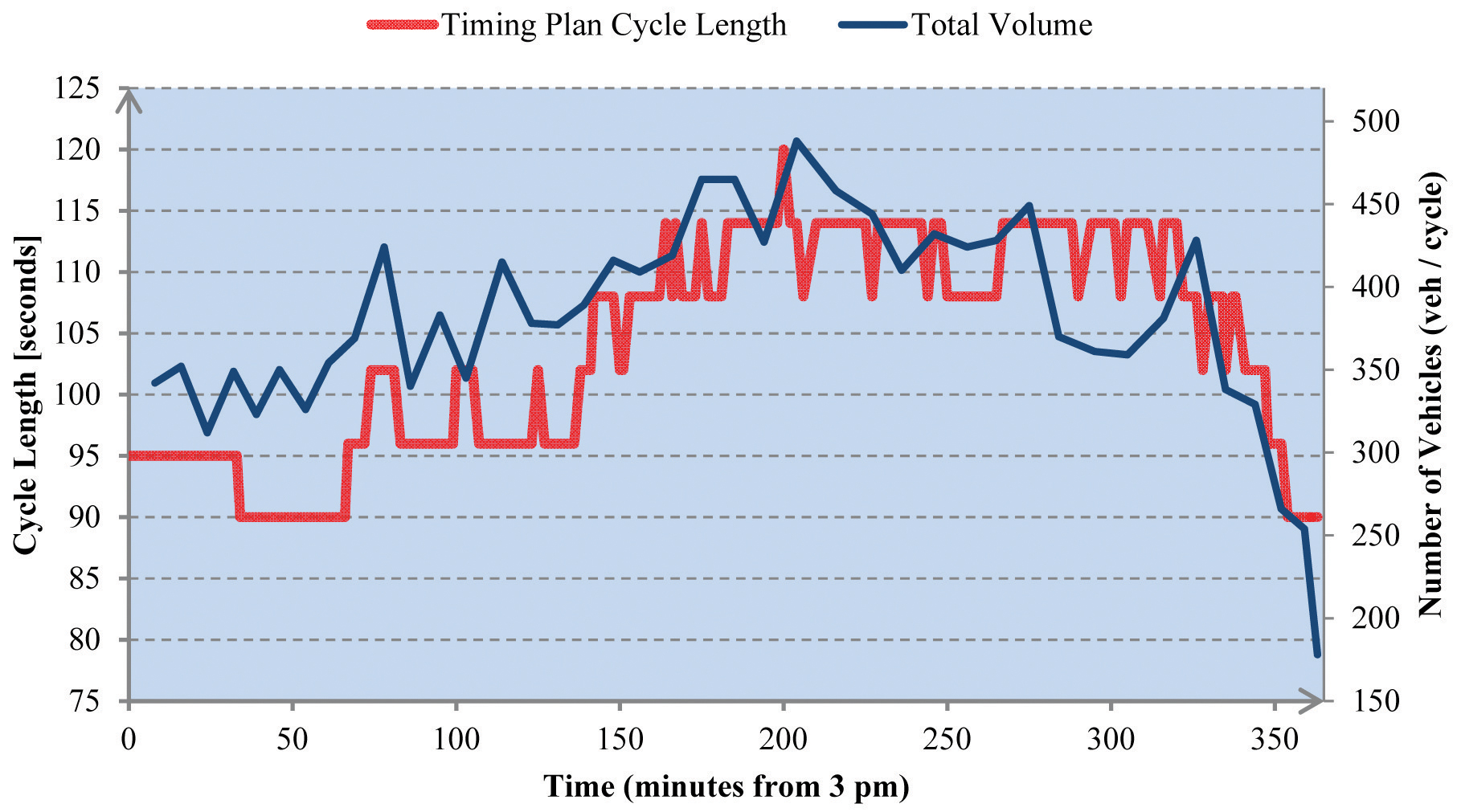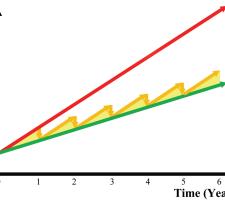
Figure 1: Total Volumes vs. Cycle Length at 72 Ave. & 122 St. in Surrey BC, on August 2, 2012
The use of a digital computer to control traffic signals was initiated in Toronto in 1963, but this computer system, which required a five-ton air conditioning unit to keep it cool and operational, was merely a gigantic clock which initially used pre-determined signal plans to regulate traffic flows in different periods of the day. We had a signal plan for every occasion – rush hour plans, holiday plans, a baseball plan, and even a snow plan.
We then invented traffic responsive control. Now the computer could intelligently select the right signal plan from a table based on traffic conditions indicated by detectors. For many years, traffic responsive control has been an integral part of the majority of traffic systems offered in the market. However, this control technique has seldom been used because it does not eliminate the basic requirement for signal improvements – signal plan update.
Adaptive control became commercially available in the late 70s and was offered as a total solution, including the central computer, controllers and the interface units, as well as the fixed time portion of the signal system. Such systems were expensive and not within easy reach of the average municipality. It was not until recently that lower cost systems were offered which allow the user to implement adaptive control on an incremental basis. However, some experts would argue that these are not truly adaptive control systems.
Definition of adaptive control
The definition of adaptive control has been modified in the last decade but early pioneers chose the word ‘adaptive’ carefully. An adaptive control methodology has to contain an on-line model which can accurately describe traffic flow behaviour along a signalised corridor and its relationship with cycle, split, and offset. The potential performance of various signal settings is evaluated by an algorithm as it searches for the optimum. The derived timing changes are implemented in small but frequent increments to avoid drastic disruption to the traffic flow. It follows that adaptive control should not simply adjust timings or skip phases based on some rules of thumb. The adaptive methodology has to be robust and yet stable enough to be able to deal with a wide range of traffic conditions in different locations.Many agencies lack the resources needed to update their signal plans regularly and only make ad hoc local changes in response to complaints, while some have more structured programs with annual budgets to retain consultants to re-design signal timings along selected corridors. Even so, these agencies typically update their signal settings only once every five years. In fact, traffic signal operation in our cities has not been satisfactory. According to National Traffic Signal Report Cards released by the National Traffic Operation Coalition based on self-assessment by 241 agencies in North America, the average grade was D- in 2005, D in 2007 and D+ in 2011. Conditions in other parts of the world are not expected to be any better, so there is obviously room for improvement. Signal timing plans age over time depending on the traffic trend in the area and the growth of the city. A previous study indicated that a well-tuned signal plan can age between 5 to 12% per year. In fact, with the time required for data collection and analysis, a signal plan may well be obsolete the moment it is implemented on the street. Based on the above, adaptive control should be a welcome tool for most agencies.
Table I summarizes various types of traffic variations and how they can be coped with by different control strategies. In the case of short term variations, while a well-tuned signal plan may accommodate the regular daily pattern, certain happenings, such as rainy weather, may cause a ‘temporal shift’ and delay the rush hours by a few minutes. Events on an adjacent street may cause a ‘spatial shift’ and introduce additional traffic onto the arterial in question. These trends will reduce the effectiveness of fixed time plans but could be accommodated by adaptive control.
For medium term variations, construction activities are the most challenging for operators and certainly very frustrating for daily commuters. Some cities insist that the construction contractor includes signal timing updates in his scope of work, while others rely on the old standby – the traffic police. Many others simply give up due to lack of data and resources. An adaptive control system with a robust algorithm and compatible with wireless communications and off-road detectors, which are not susceptible to construction damage, will go a long way in reducing driver frustration, particularly for construction over a prolonged period.
Signal plans age
In the long term, signal plans age as the city develops but they can be updated manually to cope with the growth. However, the traffic pattern is unpredictable until stabilised after a new development takes place, rendering fixed time plans ineffective.Traffic fluctuates more than we know because we never have enough detectors to tell us about the fluctuations. Rare events that cause traffic problems are not rare. They are unique individually and therefore difficult to plan for and together they can cause significant deterioration in the quality of life in the community.
In Figure 1, the total traffic volume at an intersection in the city of Surrey steadily increases during and beyond the evening peak period until almost 9:00pm due to an event at a religious congregation nearby. With adaptive control, the signal cycle tracks the traffic volume until it has subsided. Without it, the signal cycle would have remained at 90 seconds throughout, which would cause significant inconvenience to all travellers using the intersection. The cycle length does not necessarily track the intersection volume on a one to one basis as it is co-optimised with split and offset in an integrated fashion. However, the real-time data in this figure effectively illustrate the advantage of adaptive control in dealing with special events.
Drastic improvements
The benefit achieved by adaptive control depends on the base condition of the corridor in question. Drastic improvements are often observed if the base condition is uncoordinated and free running. On the other hand, if adaptive control is applied to a quiet corridor with a set of well-tuned signal timings, benefits, if any, are expected to be small. The challenge however is whether the benefit initially gained over the base condition can be sustained from year to year as the signal plan ages. Adaptive control should therefore be evaluated a few years after its implementation. Figure 2 depicts the performance trends of fixed time system versus adaptive control over a number of years. The gap between them widens as adaptive control continuously updates signal timings automatically. If the fixed time plan is updated every year, the gap would be much reduced but because the manual updating is a discrete process, the potential delay savings within the yellow triangles are never recovered.If the signal plan ages 25% over five years, which is a very conservative estimate, the performance gap between the two systems is 62.5%, two and a half times the ageing. A commuter who spends 300 seconds in each direction in an urban corridor would spend 26 hours more per year (based on 250 working days). If the signal timing is updated every year, an average of 2.5% extra delays is caused totalling 12.5 % over the five year period, equivalent to a wastage of only five hours per year. If the update is performed twice during the five year period, and this is the best any agency can do, the delay gap will be 31.25%, equivalent to some 13 hours per person per year. These figures can easily be extended to estimate the magnitude of economic and environmental benefits of adaptive control. For the city of Surrey, the estimated saving along its adaptive corridor based on $10 per hour of delay is $868,000 over five years for an investment of some $200,000. The lost delay savings (in the yellow triangles) are often neglected in adaptive control evaluation and its benefit under-estimated as a result.
Despite the benefit of adaptive control, its implementation has not been widespread for a number of reasons. Until recently, most adaptive systems are proprietary in nature and only interface with certain brands of controllers and types of detector technologies. The algorithms are often complicated and difficult to understand. Their heavy data needs lead to costly detector and stringent communications requirements. These factors contribute to considerable system cost, and partial or incremental implementation is either impossible or at a premium.
Important considerations
Adaptive systems today are more open and flexible but vary considerably in features provided. The following are important considerations for selection. The heart of an adaptive control system is the adaptive algorithm which should be based on sound traffic engineering principles and able to deal with a wide range of traffic levels from light to congested conditions, using different optimisation criteria. It should contain a robust mathematical model which can be fine-tuned or calibrated for local conditions. It should optimise cycle, split and offset in an integrated manner and produce rational timings which do not violate driver expectation and hence safety. Timing changes should be implemented incrementally but as frequently as once per cycle.To reduce initial and expansion costs, the system should be able to integrate with most, if not all controllers the agency possesses, both NTCIP-based or legacy ones. For the same reason, the detector requirement has to be reviewed carefully. Most agencies already have existing detectors, perhaps in various technologies. If these detectors can be re-used, much money can be saved and implementation achieved more quickly and smoothly. Communications used to be a major cost item for adaptive systems but with recent advances, users should be able to expect a flexible and cost-effective solution.
In terms of system operation, the new adaptive system should be able to co-exist with the legacy one and the operator should be able to transition smoothly between the two. This feature is very important because it allows the user to introduce adaptive control incrementally into his operation in a non-intrusive manner without replacing the entire system or worse still, having to justify replacing the existing system.
Without question, a friendly user interface and an effective configuration tool are required. It would be useful to have a background mode of operation which allows the operator to observe adaptive control offline and switch to real time operation when satisfied. The reverse should also be possible. In addition, the provision of an in-the-loop simulation module to evaluate before and after conditions can help the user to fine tune the system. Such a tool is also very effective in facilitating operator training and expansion planning.
Adaptive control is feasible technically and economically, and can be justified based on the signal plan ageing phenomenon alone. The best approach is to implement it incrementally based on the above selection criteria. But remember, those yellow triangles in Figure 2 are growing day by day. The more you hesitate, the more potential delay savings you are going to lose forever. Table 1: Traffic control Strategy vs. Traffic Variation
| Trend | Variation | Fixed-Time Control | Traffic Responsive | Adaptive Control |
|---|---|---|---|---|
| Short Term | 15 Minutes | Impractical | Impractical | Yes |
| Hourly | More Plans Required | Yes | Yes | |
| Temporal Shift | No | No | Yes | |
| Spatial Shift | No | No | Yes | |
| Medium Term | Construction | Limited | New Plans Required | If Detector intact |
| Daily | Impractical | Yes | Yes | |
| Weekly | Impractical | Yes | Yes | |
| Long Term | New Generator | Stabilization Period Required | New Plans Required | Yes |
| Seasonal | Impractical | Yes | Yes | |
| Annual Growth | More Frequent Updates (6 months) | Plan Updates Required | Yes |













